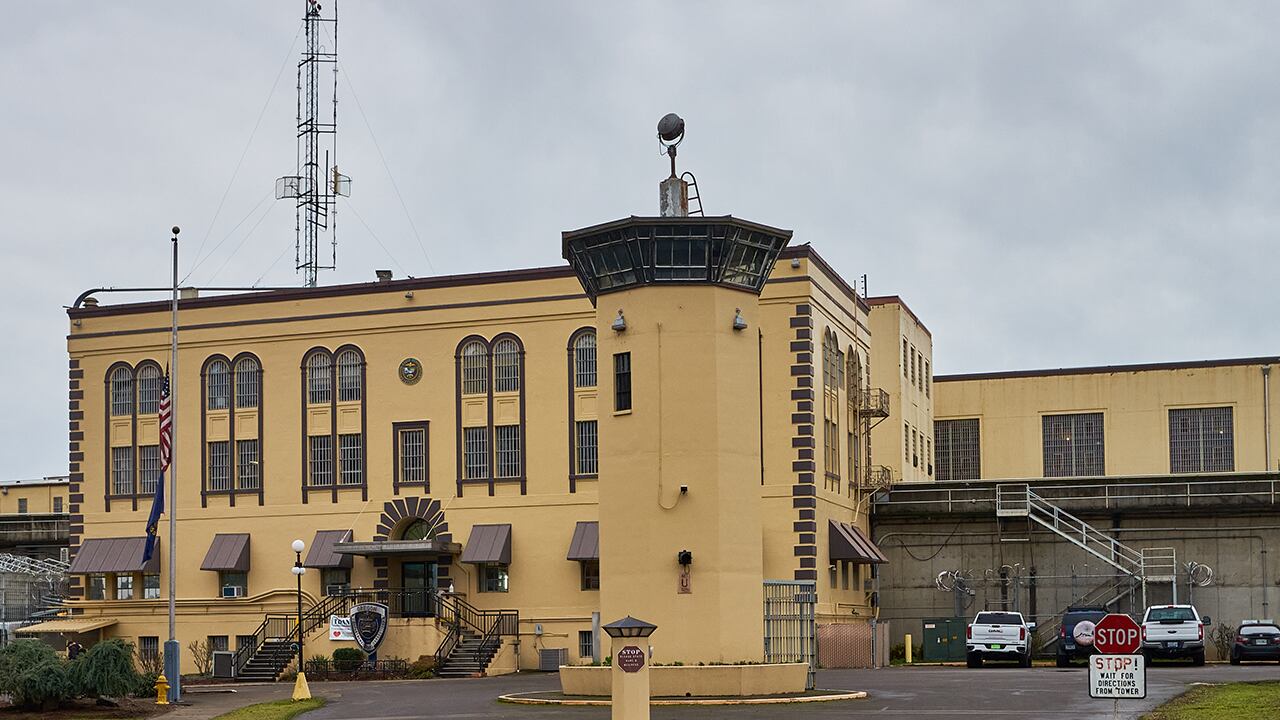It had been a long night, and Derrick Jermaine Jay wanted a cup of coffee. That was a bad idea.
On the morning of Sept. 9, 2020, Jay awakened on the floor of the Oregon State Penitentiary. He and the 250 or so other men who had slept on the floor around him didn't get the best night of sleep. They had arrived in the middle of the night after standing outside the prison under a blood-red sky for hours as ash rained down.
The men had been evacuated from Oregon State Correctional Institution—a mere 5 miles away—as the Beachie Creek Fire burned to the east. At their new location, they didn't get a warm reception.
"One of the inmates was like, 'This coffee tastes funny,'" Jay told WW. "The officers were the ones who took the coffee from us and were like, 'Somebody peed in the coffee.'"
By then, however, several men around him had already sipped it, Jay says.
When he went out into the yard, Jay, who is Black, interacted with other Black inmates who warned him about eating the food being prepared by other prisoners.
"Hey, dude, don't eat the food. The white dudes in the kitchen are putting stuff in the food," Jay, 48, recalls an OSP inmate telling him. The reason, they explained: White supremacist gang members were taking vengeance on inmates who had defected from their gang.
One of the OSP inmates handed him soup and potato chips through the fence. That was a relief, because earlier, Jay says, he had found a piece of electrical wire in his cafeteria food.
"I heard OSP inmates calling out and identifying 'gang dropouts' from OSCI and saying they were going to attack them," Jay said in a declaration submitted in November in Marion County Circuit Court. Jay, who is imprisoned on an armed robbery conviction, said he witnessed multiple gang fights break out. "The facility did not seem to take any precautions to keep rival gangs separated."

Jay had been evacuated away from a wildfire and into the center of a simmering prison gang fight.
In early September, against the backdrop of a global pandemic, the state was burning. The wildfires engulfed over a million acres, prompting the evacuation of more than 2,500 Oregon inmates from four different prisons, three of them into the state penitentiary.
It was a remarkable improvisation. And despite media reports at the time describing squalid conditions, the Oregon Department of Corrections praised itself for the handling of evacuations.
Brandon Kelly, superintendent at Oregon State Penitentiary, said in an interview with WW that if he were to grade how the department managed the wildfire evacuations, he would give it an A.
"Were there a couple lessons learned? Absolutely. But given the circumstances and the extreme emergency and the threat to their physical safety should the fire turn to that direction, I think that we did an amazing job," Kelly said, adding that an inmate told him DOC staff "scored a touchdown."
But that assessment conflicts with the accounts of five inmates who spoke to WW, as well as the written declarations of four other prisoners submitted on the record in both state and federal court.
Those inmates say the turmoil began when gang members retaliated against former gang members, or "dropouts," through physical assault and contamination of food and drink.
Mitchell Randall, a gang dropout, said in a written declaration submitted to federal court that he was "mentally shaken" when he learned he was being evacuated to Oregon State Penitentiary, because he might see former associates.
"OSP kitchen workers were messing with our food," he wrote. "My vegetables tasted like soap one day and there were other debris in our food. There was a bloody Band-Aid in the mac 'n' cheese. It was very traumatic."
Jennifer Black, a spokeswoman for the Department of Corrections, says much of it didn't happen. "If a person were to sabotage the food, it's likely they would end up eating that food or serving it to their friends," she says. "OSP reviewed video footage of the preparation of meals and found no evidence to suggest any of the food was tampered with during preparation." The Band-Aid, she says, was an accident.
Since September, the Oregon Justice Resource Center and Oregon Physicians for Social Responsibility have called on the governor and the Oregon Legislature to conduct an independent investigation of the wildfire evacuations.
At least one state lawmaker is on board: Rep. Maxine Dexter (D-Portland). "It is important we have a full accounting of what occurred in DOC facilities during and immediately after the wildfires," she says, "to ensure this doesn't happen again."
Rep. Dexter was one of two legislators who toured OSP after the wildfire evacuations. The other was Sen. Elizabeth Steiner Hayward (D-Portland), who declined to comment.
Rep. Janelle Bynum (D-Clackamas), co-chair of the House Judiciary Committee, says she's discouraged to the point that she no longer trusts the investigative process. "I don't know that we would get useful information in a timely fashion that we could act on," she says, "and I'm not sure who would do it."
Since the fall, lawmakers have been asking DOC for a copy of its report on the evacuations. Hours before WW's story published, DOC released the report, which was largely glowing. "Issues were resolved as quickly as possible, avoiding small issues from becoming big issues," it said.
A spokeswoman for Gov. Kate Brown declined to say whether the governor believes an independent investigation is necessary. Through her spokeswoman Liz Merah, Brown declined to comment for this story.
"We look forward to reviewing the [DOC] report," Merah said.

During the wildfires, inmates of three prisons were evacuated to Oregon State Penitentiary: Mill Creek Correctional Facility, Santiam Correctional Institution and Oregon State Correctional Institution. All three were about 5 miles from OSP, or a 10-minute drive along the freeway.
DOC spokeswoman Jennifer Black says the agency decided to move inmates to OSP—the state's oldest prison and its only maximum-security facility, built in the 1800s—because its 25-foot-high concrete walls provided protection from fires that other prisons didn't have.
Of the three prisons that were evacuated, the most turmoil arose among inmates evacuated from Oregon State Correctional Institution, which is known by prisoners and lawyers alike as the "gang dropout" prison in Oregon. (Black says that's not an official designation.)
In other words, when inmates drop out of a gang, they are often housed at OSCI, where they are supposed to be free of retaliation for dropping out. OSCI also houses men who are under some form of protective custody—for acting as informants to police or prosecutors, for example.
But the prison into which its inmates were evacuated—OSP—is a hot spot for gangs among Oregon prisons, lawyers and prisoners say.
"When I went over there [to OSP], I'm thinking, I'm going to die because I'm not supposed to be going over there," said Gary*, an inmate at OSCI who was evacuated. He tells WW he previously provided information to an investigator and is therefore a target among OSP inmates. "I was thinking, this is a death sentence. One of the good things about wearing the mask is, it kind of hides your identity."
Tara Herivel, an Oregon lawyer who represents prisoners, says it is the prison's responsibility to keep known gang members separated from each other.
"Why is it a problem not to keep people separated based on affiliation?" Herivel says. "Because they'll kill each other. It's been the protocol since the beginning of prisons to separate known gang members from their adversaries, or dropouts, so they don't kill each other."
Among the main groups responsible for conflict, according to the prisoners who spoke to WW, were two white supremacist gangs: European Kindred and Insane Peckerwood Syndicate, otherwise known as IPS.
Randy Blazak, an expert on extremism in the Pacific Northwest, estimates there are about 20 major gangs in Oregon prisons, and 200 or so subgroups of those gangs. The gangs tend to be divided along racial lines.
All of these groups converged in the chow hall, prisoners said. In addition to IPS and European Kindred, prisoners told WW the Southsiders, a Latino gang, were among the groups that fought. But it wasn't limited to these three groups, and the fighting was not between different gangs: The gangs at OSP targeted former members, men who used to be in their pack but dropped out.
And when the men from opposing prisons couldn't come into direct contact with one another, OSP inmates—who had the home field advantage—allegedly retaliated through other means: the food.

Such was the case for William Harvey, a dropout gang member who was transferred to OSP during the evacuations.
"There were OSP [inmates] delivering our food, delivering our sheets and blankets, and cooking our food," Harvey said in a written declaration submitted to federal court in late September. "One day I saw a bloody Band-Aid in the food being delivered; those trays were returned to the kitchen and replaced with sack lunches, but after that they kept feeding us hot trays from the kitchen and were making us eat the food."
Assaulting former gang members isn't necessarily a choice, either, according to the rules of prison politics.
"It means that if you see that dude, you have to take him out," says Thomas*, an inmate at OSCI. "You have to get them. It's like a mandatory thing."
Kelly, the OSP superintendent, conceded that corrections officers did need to use chemical irritants like pepper spray to break up fights. In its report, DOC says inmates were "fed separately as much as possible to reduce cross contact." However, the report says, the OSCI and OSP inmates mixed in the chow hall.
"Several [inmate] fights occurred early in the evacuation; some were one-on-one, and some were multiple [inmates] (3-4)," the report says. "These altercations involved [security threat group inmates] and former members of their groups (dropouts). It was difficult at first to identify potential conflicts."
Beyond physical danger from adversaries, the evacuations placed inmates in another kind of danger: the pandemic.
Prior to the evacuations, there were zero reported COVID cases among inmates at OSCI, and two among staff, according to DOC's online COVID tracker. In the weeks following, infections at the prison swelled. To date, 231 inmates and 35 staff at OSCI have tested positive for the virus, including many who were interviewed for or included in this story.
"It was horrible," Jay said. "It was like they didn't care that it was a pandemic. It was like they didn't care that some inmates were getting assaulted."
*The inmate did want his real name used for fear of retribution.

